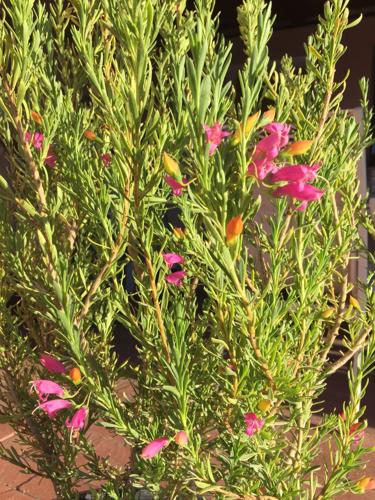Q: We have several different types of trees in our yard that have for the past three to four years been infiltrated by those large green hornworms. It is a complete puzzle to us where they come from, as we have no tomato plants or vegetable garden of any kind, and also why they keep showing up every year.
My husband has sprayed the trees with a solution that usually causes the worms to fall to the ground and thereby easy to find and dispose of, but why are we having this problem year after year and what can we do to avoid it? The trees we find them in are ash and willow. Any advice you can give would be appreciated.
A: The hornworm caterpillars you are finding are related to the tomato hornworm but not necessarily the same species. Tomato hornworms feed on potato, tobacco, tomato, and other plants in the nightshade family (Solanaceae). Other species of hornworms will feed on other plants such as your trees.
The sphinx or hawk moth family (Sphingidae) to which the hornworms belong includes about 125 species in North America. Around 40 or so of these can be found in Pima County. They are called hornworms due to the conspicuous horn on the back end of their abdomen and that is a clue that helps identify them as members of this family.
The adult moths, which are excellent flyers, lay eggs on their host plants, often at night. These caterpillars are not considered to be pests on trees since trees can handle some defoliation without any adverse affects. The caterpillars are also a good food source for birds so you can leave the pest management to them and save yourself some time and money on the insecticides.
Plus, I am guessing you don’t want the birds to eat caterpillars laced with insecticides. There is no practical way to avoid this situation in the future. You like your trees and the caterpillars have to eat.
Q: A saguaro cactus in my parent’s yard has something moving into it. But I was wondering if you knew what the black stuff was. When I disturbed it, some gnats flew from it, which I thought was weird.
A: The black stuff is a fungus that is growing on the excavated cactus parts that were kicked out of the hole and stuck to the spines. The fungus gnats you saw flying from the fungus are just feeding on that and not really a problem for the cactus.
Q: I had an Eremophila racemosa for about three years until last week when it just dried up and died on me. I don’t know what happened. Is there some kind of insect that could have killed my bush? Also I would like to know about removing a stump from a tree that was cut down last year. I remember reading in your Sunday articles about how to remove a stump with some kind of natural items.
A: The emu shrub (Eremophila racemosa) is a desert-adapted plant from Australia. These plants are relatively free of insect pests, so I suspect that lack of water was the cause of its demise. In the summer, it is best to provide water every 7 to 14 days to a depth of 24 to 36 inches. In the spring and fall you can adjust your irrigation to water every 10 to 21 days and in the winter, every 14 to 21 days.
Stumps will naturally degrade in the soil. Depending on the size of the roots and the nature of your soil, it may take years to completely decompose. Fortunately for us, warmer soil temperatures are one factor that speeds up the process.
Other factors than can speed up the process include aerating the soil around the stump, irrigation of the stump as long as the water doesn’t accumulate, adding a small amount of nitrogen fertilizer and a layer of compost will help provide the microorganisms that break down the stump, and drilling holes in and/or scaring the stump and above ground roots provides access to fungi and bacteria that will aid in the process.
Q: I was in a shopping center yesterday and watched a landscape crew trimming the trees, if trimming is the word for what they were doing. I know little about the subject, but why would they cut so far back? There must be some good reason. We don’t get hurricanes, so that isn’t it.
A: There is no good reason for what was done to those trees. The pruning style is called tree topping and it is simply bad for the trees. Trees require a large leaf surface area to provide food for maintenance and growth.
Topping cuts off a major portion of the food making potential and depletes the stored reserves. While removing most of the buds that would form a normal branch system, topping often stimulates the regrowth of dense, unattractive, upright branches (water sprouts) just below the pruning cut. Water sprout regrowth is vigorous. A topped tree will rapidly return to its original height, but will lack its original form.
The branch wounds left from topping are slow to close, therefore more vulnerable to insect attacks and fungal decay. An invasion by either pest can spread into the trunk, killing the tree. Weakened stubs are more prone to wind and storm breakage because they generally begin to die back or decay.
Increased sun exposure on trunk and branches can lead to severe bark damage. Ugly branch stubs, conspicuous pruning cuts, and a broom-like branch growth replace natural beauty and form.
Topping reduces the real estate value of trees by 20 to 100 percent. A correctly trimmed tree increases in value at each pruning. If tree workers suggest topping, I would hire somebody else. I recommend using ISA Certified Arborists whenever possible to assure that your tree workers have received the proper training and passed an exam on the topics most critical to good tree care.





